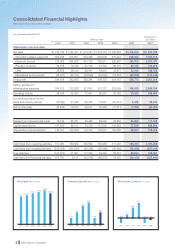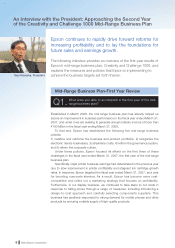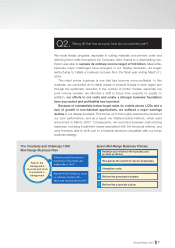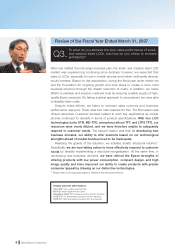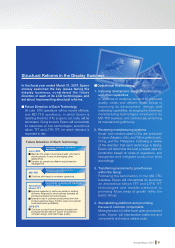Epson 2007 Annual Report Download - page 12
Download and view the complete annual report
Please find page 12 of the 2007 Epson annual report below. You can navigate through the pages in the report by either clicking on the pages listed below, or by using the keyword search tool below to find specific information within the annual report.
10 Seiko Epson Corporation
Small- and medium-sized display business
2008: Improvement in profitability
2009 onwards: Return to the black
Value of profitability
improvements
driven by structural reforms
Expected Display Business Improvements in 2008 and Beyond
Overall impact of impairment losses: ¥40.6 billion*(Billions of yen)
* Figures based on the forecast announced at the same time as the display business structural reforms in March 2007
20092008 2010 Total
¥11.3 ¥6.9 ¥3.3 ¥21.5
Decline in fixed costs
Years ending March 31
The previous reforms wereaimed primarily at the semiconductor business. These
reforms involved the consolidation and integration of production sites and the
reorganization of production lines. In the display business, the only reforms we
made involved booking impairment losses to reduce fixed costs in the MD-TFD
business, which we expected to face severeprofitability issues.
The current reforms areprimarily aimed at the display business but will be
drastic as the measures involve reviewing the futuretechnological direction.
In the fiscal year under review,we highlighted the problem of our resources being
overly diluted due to operations being spread over four technologies and our
subsequent shortcomings with regardto responsiveness to customer needs.
Epson thoroughly examined this issue and began making reforms, which led to our
booking business restructuring expenses. This, in turn, enabled us to lower fixed
costs and, consequently,to take the initial steps toward rebuilding the business.
It’strue to say that we’ve started to rebuild our display business by implementing
structural reforms.
However, I am proud to say that we still have some of the most advanced
technologies and areone of the most stable suppliers in the industry,both of which
serve as inherent strengths. Now,with lower fixed costs, and after the steady
implementation of structural reforms, I believe this business will have the potential
to once again contribute to Epson’sbottom line.
As a result, displays remain an important business for Epson, and we are
making everyeffortto rebuild.
Q4. What is the position of the display business within
Epson now?
Q5. How arethe current structural reforms different from those that were
carried out in the fiscal year ended March 31, 2006?




